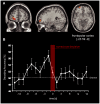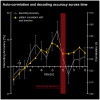Tracking the unconscious generation of free decisions using ultra-high field fMRI
- PMID: 21760881
- PMCID: PMC3124546
- DOI: 10.1371/journal.pone.0021612
Tracking the unconscious generation of free decisions using ultra-high field fMRI
Abstract
Recently, we demonstrated using functional magnetic resonance imaging (fMRI) that the outcome of free decisions can be decoded from brain activity several seconds before reaching conscious awareness. Activity patterns in anterior frontopolar cortex (BA 10) were temporally the first to carry intention-related information and thus a candidate region for the unconscious generation of free decisions. In the present study, the original paradigm was replicated and multivariate pattern classification was applied to functional images of frontopolar cortex, acquired using ultra-high field fMRI at 7 Tesla. Here, we show that predictive activity patterns recorded before a decision was made became increasingly stable with increasing temporal proximity to the time point of the conscious decision. Furthermore, detailed questionnaires exploring subjects' thoughts before and during the decision confirmed that decisions were made spontaneously and subjects were unaware of the evolution of their decision outcomes. These results give further evidence that FPC stands at the top of the prefrontal executive hierarchy in the unconscious generation of free decisions.
Conflict of interest statement
Figures







References
-
- Wegner DM. The mind's best trick: how we experience conscious will. Trends Cogn Sci. 2003;7:65–69. - PubMed
-
- Haggard P. Conscious intention and motor cognition. Trends Cogn Sci. 2005;9:290–295. - PubMed
-
- Custers R, Aarts H. The unconscious will: how the pursuit of goals operates outside of conscious awareness. Science. 2010;329:47–50. - PubMed
-
- Kornhuber HH, Deecke L. Hirnpotentialänderungen bei Willkürbewegungen und passiven Bewegungen des Menschen: Bereitschaftspotential und reafferente Potentiale. Pflüglers Arch für die gesamte Phys des Menschen u der Tiere. 1965;284:1–17. - PubMed
-
- Libet B, Gleason CA, Wright EW, Pearl DK. Time of conscious intention to act in relation to onset of cerebral activities (readiness-potential): the unconscious initiation of a freely voluntary act. Brain. 1983;106:623–642. - PubMed
Publication types
MeSH terms
LinkOut - more resources
Full Text Sources
Other Literature Sources
Medical

